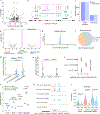Combined single-cell profiling of chromatin-transcriptome and splicing across brain cell types, regions and disease state
- PMID: 40696189
- PMCID: PMC12425497
- DOI: 10.1038/s41587-025-02734-5
Combined single-cell profiling of chromatin-transcriptome and splicing across brain cell types, regions and disease state
Abstract
Measuring splicing and chromatin accessibility simultaneously in frozen tissues remains challenging. Here we combined single-cell isoform RNA sequencing and assay for transposase accessible chromatin (ScISOr-ATAC) to interrogate the correlation between these modalities in single cells in human and rhesus macaque frozen cortical tissue samples. Applying a previous definition of four 'cell states' in which the transcriptome and chromatin accessibility are coupled or decoupled for each gene, we demonstrate that splicing patterns in one cell state can differ from those of another state within the same cell type. We also use ScISOr-ATAC to measure the correlation of chromatin and splicing across brain cell types, cortical regions and species (macaque and human) and in Alzheimer's disease. In macaques, some excitatory neuron subtypes show brain-region-specific splicing and chromatin accessibility. In human and macaque prefrontal cortex, strong evolutionary divergence in one molecular modality does not necessarily imply strong divergence in another modality. Finally, in Alzheimer's disease, oligodendrocytes show high dysregulation in both chromatin and splicing.
© 2025. The Author(s).
Conflict of interest statement
Competing interests: L.C.N. is a scientific advisor to Abbvie and ViiV Healthcare and a board director member for Cytodyn and has financial interests in Ledidi, all for work unrelated to this study. H.U.T. has presented at user meetings of 10x Genomics, ONT and Pacific Biosciences, which, in some cases, included payment for travel and accommodations. The other authors declare no competing interests.
Figures





References
Grants and funding
- R01 GM135247/GM/NIGMS NIH HHS/United States
- U01 DA053625-01/U.S. Department of Health & Human Services | NIH | National Institute on Drug Abuse (NIDA)
- U01 DA053625/DA/NIDA NIH HHS/United States
- 2T32DA039080/U.S. Department of Health & Human Services | NIH | National Institute on Drug Abuse (NIDA)
- R01 MH134391/MH/NIMH NIH HHS/United States
- RF1 MH121267/MH/NIMH NIH HHS/United States
- R01 MH125956/MH/NIMH NIH HHS/United States
- R01 NS123562/NS/NINDS NIH HHS/United States
- 1RF1 MH121267-01/U.S. Department of Health & Human Services | NIH | National Institute of Mental Health (NIMH)
- GRFP # 2139291/National Science Foundation (NSF)
- U01 DA058527/DA/NIDA NIH HHS/United States
- R01 MH125737/MH/NIMH NIH HHS/United States
- T32 DA039080/DA/NIDA NIH HHS/United States
- R01 MH130197/MH/NIMH NIH HHS/United States
- 1R01 GM135247-01/U.S. Department of Health & Human Services | NIH | National Institute of General Medical Sciences (NIGMS)
LinkOut - more resources
Full Text Sources

